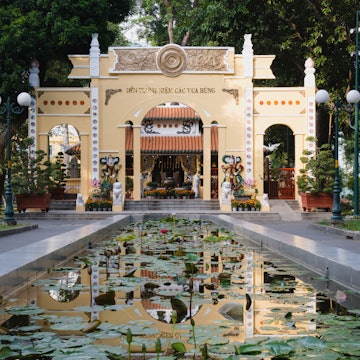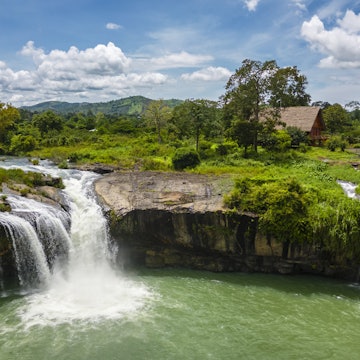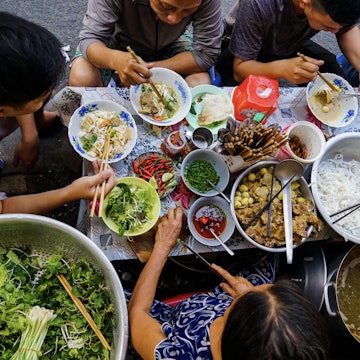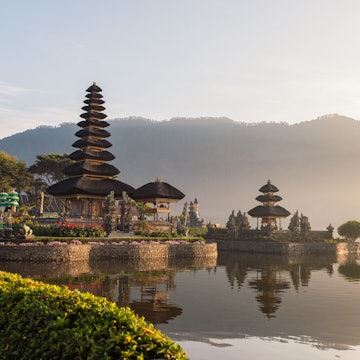

Vietnam offers a dizzying platter of breathtaking natural wonders. Shutterstock
Natural wonders appear everywhere you turn in Vietnam. If you take an atmospheric ride on one of Vietnam's long-distance trains – the Reunification Express, perhaps, linking Hanoi and Ho Chi Minh City (HCMC) – you'll witness an endless patchwork of almost impossibly green rice paddy fields, broken up by sand-lined bays and highlands cloaked in dense forest.
Then there are the coastal karst islands of Halong Bay, Lan Ha Bay and Bai Tu Long Bay – a vision of ethereal beauty, whether viewed from a cruising junk or a bobbing kayak. At Mui Ne in the deep south, you can wonder at a Sahara-esque landscape of wind-sculpted dunes from the basket of a hot-air balloon. In the stupendous karst mountains of the far north, bewitching natural landscapes unfold around every corner.
To help you build a trip around bounteous nature, here are our favorite natural wonders in Vietnam.

1. Halong Bay
Best for coastal views
With its stunning combination of karst limestone islands and sheltered, shimmering seas, it's no surprise that Halong Bay is one of Vietnam’s top tourist draws. But with more than 2000 greenery-capped limestone islands to explore, there’s plenty of superb scenery to go around.
To maximize the gazing time, book an overnight cruise around the bay and make your own special moments in this World Heritage-listed natural wonder. Rise early for an ethereal misty dawn, or pilot a kayak into the mouths of flooded grottoes and across secret lagoons.
Detour: If you’re hankering for more karst action, move on to less touristy but equally spectacular Lan Ha Bay. Most tourists visit on a one-night cruise, but if you can, consider a longer 2- or 3-night trip to see more of the islands, with more time for kayaking, hiking and swimming.
2. Phong Nha-Ke Bang National Park
Best for underground adventures
With jagged highlands shrouded in rainforest, and mountain rivers coursing through impressive ravines, Phong Nha-Ke Bang is one of Vietnam's most spectacular national parks. Head underground for even more proof that this wonderful natural area belongs on any Vietnamese itinerary. We've given legendary Hang Son Doong its own entry later in our list, but the world's largest cave is just the showpiece of a national park that is worm-holed with caverns.
Amongst the more accessible caves at Phong Nha-Ke Bang are Hang Toi (Dark Cave), an atmospheric hub for ziplining and kayaking, and aptly named Paradise Cave, an other-worldly beauty filled with giant stalactites and stalagmites.
Planning tip: The easiest way to explore Phong Nha-Ke Bang National Park is on organized tours from the town of Son Trach, but note that many caves are closed during the wet season from mid-September to late November or early December.

3. Hang Son Doong
Best for journeys to another world
Hidden away in the jungles of Phong Nha-Ke Bang National Park, Hang Son Doong (Mountain River Cave) is believed to be the world's largest cave, and it's one of the most spectacular – and exclusive – sights in Southeast Asia. Public access was only approved by the government in 2013, and entry is only permitted to controlled numbers of people on organized tours.
This monster cavern was discovered surprisingly recently, by Ho Khanh, a hunter from a jungle settlement close to the Vietnam–Laos border. He stumbled across the gargantuan Hang Son Doong cavern in the early 1990s while seeking shelter in his mountain homeland, but the sheer scale of the cavern was only confirmed when British explorers returned with him in 2009.
Visiting Hang Son Doong is expensive but truly spectacular. The majestic principal cavern is more than 5km long, and the roof is 200m high in places, reaching a maximum width of 150m. Expeditions involve days of trekking and overnight stops at campsites inside the caverns.
Planning tip: All trips to Hang Son Doong must be organized through the tour agency Oxalis, with bookings opening up two years in advance, and spaces selling out quickly.
4. The Tonkinese Alps
Best for mountain views and tumbling rice terraces
The spectacular Tonkinese Alps (Hoang Lien Mountains) soar skywards along the rugged, uncompromising northwest fringes of Vietnam, taking their name from the old French term for this corner of Southeast Asia. The dramatic range includes 3147m Fansipan, Vietnam’s highest peak, which can be climbed on a challenging day hike from the gateway town of Sapa.
There's more to see here than glorious mountains. From sinuous and spidery ridges, spectacular rice terraces cascade down into river valleys that provide a home for Vietnamese ethnic minority groups such as the Hmong, Red Dzao and Giay peoples.

5. Phu Quoc
Best for beach lovers
Lapped by azure waters and hemmed by the kind of white-sand beaches that make sunseekers sink to their knees in praise, Phu Quoc is Vietnam's most beautiful island escape. This paradisiacal getaway is way down in the south of Vietnam, but you can fly here directly from cities across Southeast Asia, and visitors are free to stay visa-free for up to 30 days.
The island is perfect for a hassle-free beach break – imagine days on the sand, then reaching for a seaside cocktail as a blood-orange sun dips into a vivid blue sea. In addition to beautiful beaches, more than 70% of the island is preserved as a leafy national park, full of wildlife such as macaque and langur monkeys and slow lorises, and dotted with quiet coves where you can kayak or scuba dive.
With picture-perfect white sand, the delightful curve of beautiful Sao Beach follows a blue bay of mineral-water clarity just a few miles from An Thoi, the main shipping port at the southern tip of Phu Quoc. There are a couple of beachfront restaurants where you can settle into a deckchair, change into bathers or try some of the water sports on offer.
Planning tip: If you want to get away from the crowds, rent a bike, motorcycle or scooter and hit the red-dirt roads. The island is relatively compact, around the size of Singapore, but you'll need an international driving permit to rent a motorcycle or scooter.
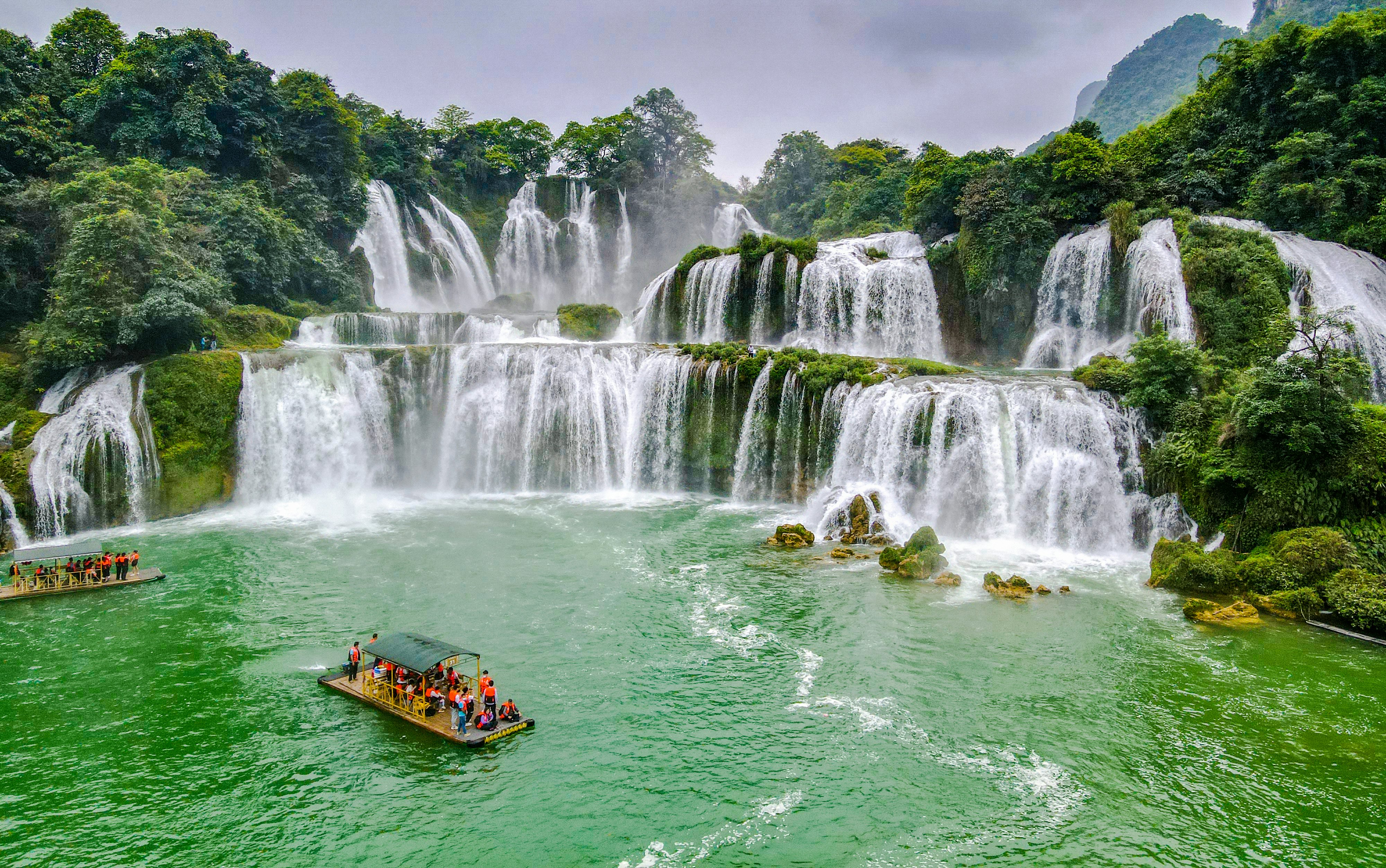
6. Ban Gioc Waterfall
Best for observing the power of nature
Tucked against the Chinese border in the far north of the country, churning Ban Gioc is one of Vietnam’s best-known waterfalls, and in photo form, it adorns the lobby of many a budget Vietnamese guesthouse. Fed by the Quay Son River, which marks the border with China, the falls reach their full force during the wet season, but the best time to visit is during the rice harvest season in September and October, when the surrounding rice fields turn a warm gold color.
Aim to visit around lunchtime when the dam upstream is opened, allowing the cascade to run at full flow. Boat owners can punt you to the cascades on bamboo rafts for a small fee, bringing you close enough to the waterfall to feel the spray on your face.
Planning tip: The falls span two countries, and each side has its own boat operators – those on the Vietnamese side have blue canopies; on the Chinese side, canopies are green.
7. Thuy Son
Best for combining nature and culture
Thuy Son is the largest and most famous of the five Marble Mountains, topped by scenic pagodas and pockmarked by natural caves that were converted into Hindu and Buddhist sanctuaries from the 17th century onwards. Sitting outside Danang, these mountains have been a hub for marble carvers for centuries, and carving workshops ring their bases (today, masons use marble imported from China).
Of the two paths heading up Thuy Son mountain, the one closer to the beach (at the end of the village) makes for a better circuit. At the top of the staircase is a gate, Ong Chon, which is pockmarked with bullet holes from the American War, leading to Linh Ong Pagoda – a delightful jumble of religious architecture, statues and greenery.

8. Ba Be National Park
Best for escaping the crowds
Detour off the regular Vietnam tourist trail in Ba Be National Park, an essential stop for adventurous travelers, with towering limestone mountains, plunging valleys, silent waterways and evergreen forests. Waterfalls, cave systems and lakes combine in a landscape that sustains more than 550 different plant species and hundreds of different species of birds and animals.
Arriving at Ba Be from Hanoi on an organized tour by chartered car – or independently using a series of connecting buses – you can explore Ba Be’s spectacular natural landscapes by boat or on trekking and mountain-biking excursions, before relaxing and recharging in rustic homestays and village guesthouses run by people from the local Tay ethnic minority.
9. Mui Ne Sand Dunes
Best for shifting sands
Accessible by open-tour bus from Ho Chi Minh City, Mui Ne is famous for its enormous red and white sand dunes, created by the action of wind over thousands of years. It's a remarkable landscape to discover amid the lush greenery of southern Vietnam. The smaller red dunes, or doi hong, are conveniently located north of the main village strip, but the more impressive white dunes, or doi cat trang, are 24km northeast.
Near-constant oceanic winds have sculpted the pale-yellow sands into wonderful Saharaesque formations, but as this is Vietnam not deepest Mali, don't expect to enjoy the scenery in silence. While the landscapes are dramatic, tours are big business and the dunes see plenty of quad bikes and dune buggies, and youngsters enthusiastically encourage visitors to hire plastic sleds to ride down the dunes.
Planning tip: To get the best from this surprising landscape, consider taking a hot air balloon ride, which will lift you up above the dunes at sunrise.








